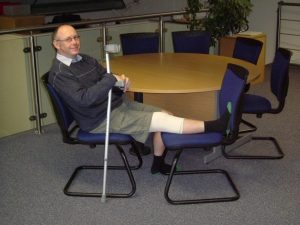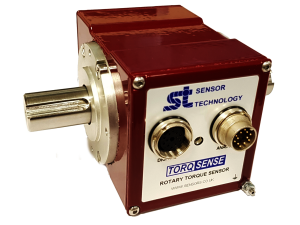Medical experts and sports scientists are becoming increasingly reliant on engineers as their disciplines become more and more technical. Mark Ingham looks at some of the projects his company, Sensor Technology, has helped behind the scenes.
Like most rugby players I took my knees for granted until the day a twisting fall resulted in a torn anterior cruciate ligament. Fortunately these days it can be fixed with surgery and nine months of physiotherapy, but I took some comfort in the fact that Sensor Technology has contributed – modestly – to the medical knowledge of this crucial joint.
 With the pending Olympics fuelling increased participation in sport, military personnel returning from active service with knee problems and the wear on tear on joints as people live longer the need for new knowledge is growing.
With the pending Olympics fuelling increased participation in sport, military personnel returning from active service with knee problems and the wear on tear on joints as people live longer the need for new knowledge is growing.
One research programme used a Sensor Technology TorqSense industrial sensor to analyse the performance of implanted replacement knee joints. To do this Sensor Technology helped develop a rig centred on a 100Nm TorqSense transducer with an extended through-shaft supporting crank arms on both ends.
The researchers very carefully align the axis of the TorqSense with the patient’s knee and attach the ankle to the end of one crank. They can then use the other crank to move the knee without the patient having to put in any muscular effort, thus isolating the joint. Data collected from the TorqSense during a test sequence builds up a profile of the knee’s performance.
TorqSense is a surface acoustic wave (SAW) based device. In a TorqSense transducer, surface waves are produced by passing an alternating voltage across the terminals of two interleaved comb-shaped arrays, laid onto one end of a piezoelectric substrate. A receiving array at the other end of the transducer converts the wave into an electric signal. The frequency is dependent upon the spacing of the teeth in the array and as the direction of wave propagation is at right angles to the teeth, any change in its length alters the spacing of the teeth and hence the operating frequency. Tension in the transducer reduces the operating frequency while compression increases it. To measure the torque in a rotating shaft, two saw sensors are bonded to a shaft at 45deg to the axis of rotation. When the shaft is subjected to torque, a signal is produced which is transmitted to a stationary pick up via a capacitive couple comprising two discs, one of which rotates with the shaft, the other being static.
Drug protection
Errors in drug delivery are being reduced year-on-year in all branches of medicine, due to advances in infusion and monitoring technologies.
Most medical pumps are driven by stepper motors, which can be tested by driving them against a DC motor acting as a brake. In one programme we were involved with a TorqSense was mounted between the two motors to record the instantaneous shaft torque during test sequences. These data were then analysed and a model of the motor’s characteristics built up.
The alternative would be to use a very expensive dynamometer, which would also be slower to set up because it would need hardwiring instead of a radio link.
Another drug protection related project was based on the observation that when using diagnostic fluids on ill or nervous patients, hospital staff are likely to be feeling the stress and will not take kindly to bottle tops that prove difficult to open. However they will want the tops to feel secure enough that they can be confident of the fluid’s sterility. Thus tightening bottle caps in pharmaceutical plants is a precision operation!
To this end Sensor Technology has helped develop specialist capping machines, which not only tighten bottle caps within precisely defined tolerance but also log every detail of every bottle. The machines are essentially simple: filled bottles are presented to a torque head, which quickly screws on a cap to a target torque.
However a batch size is typically 10,000 bottles, and they will have to be capped at say one per second. Every cap will have to hit target tightness, with the measurement logged for traceability. Sterility will be paramount, so the machine will probably operate in a high vacuum chamber to ensure that no bacteria or other contaminants are present.
TorqSense met all criteria for this application, it being simple, robustness, high speed and wireless. Basically TorqSense could be used ‘as is’; with a suitable mounting arrangements. Similarly, the associated software was ready to go after a bit of calibration and the addition of some bespoke front end graphics.
The software was required to do two things: run the torque up to 10kgcm within tolerances of 10 percent, and record the actual value achieved. This secures the cap to the bottle at a level of tightness that will ensure security and sterility, yet is at a level that can be opened relatively easily by an adult. The logged values are saved to a hard drive to provide a permanent record for traceability.
Diagnostic fluids are distributed widely, typically to every hospital in the country plus many overseas. But they may be stored for months before use. Tracing each bottle’s origin would be practically impossible without full records being automatically produced and saved to a central location.
Sensor Technology helped provide a solution to this complex but critical problem using an out of the box technology.
Wheelchair reliability
In a more conventional engineering environment a TorqSense is helping ensure the reliability of powered wheelchairs, having been incorporated into a dynamometer rolling road built by PG Drives in Dorset.
The rolling road measures the torque between the motor under test and the inertia network it is driving, which is simulated by selective use of both passive and active loads. The TorqSense constantly measures the test motor’s torque at its output shaft, logging it for later analysis.
Prolonged and arduous tests are often run, simulating on and off road, every type of surface, steep gradients, gentle gradients, all sorts of extreme weather, heavy loads, shock loads and every other anomalous behaviour you can imagine.
Before the rolling road was built, the analysis regime was based on test driving around the town, but consistency and repeatability were, of course, impossible to achieve. The rolling road has been used constantly since it was built, so its reliability and ease of use are major issues, both of which are helped by the TorqSense.
As development engineers, we at Sensor Technology never know what our next job will be. But it is heartening to think that we are making such a direct contribution to healthcare and medicine.





